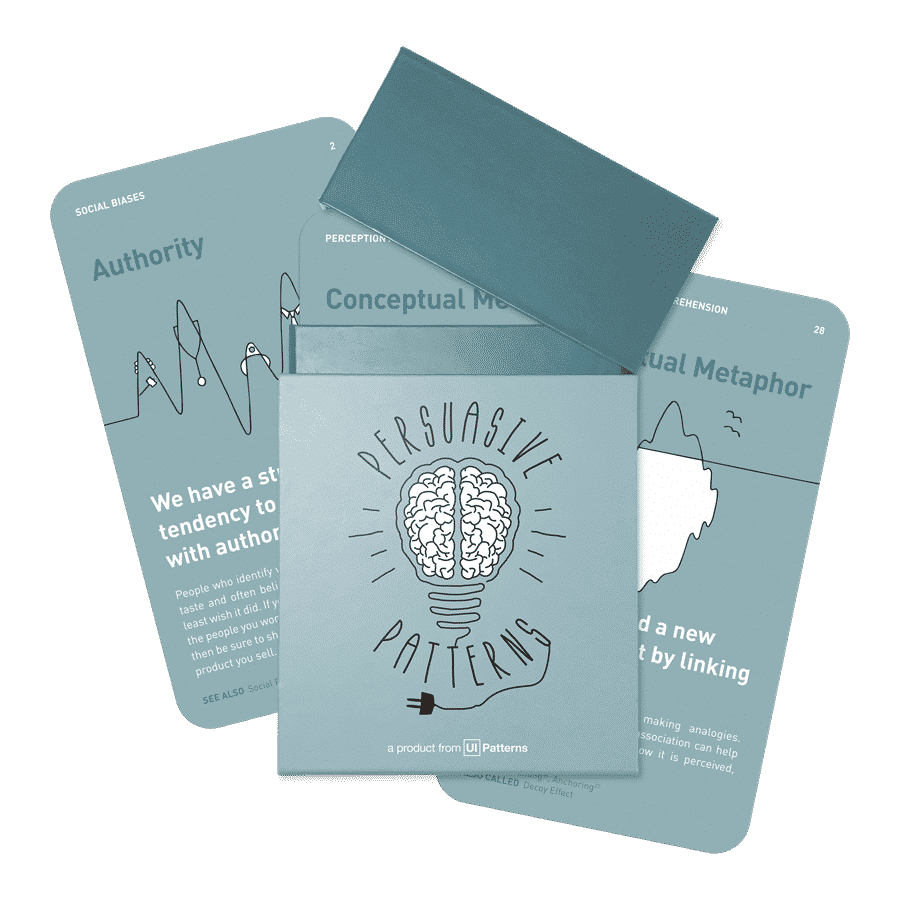Getting started with Product Psychology
Take your first steps toward applying product psychology to design user-centered products that align with business goals.
Design for behavior change with the Persuasive Patterns card deck
Apply psychological principles to influence decisions, increase engagement, and optimize user experience.
Get your deck!Building better products requires understanding the human mind. Product Psychology focuses on how users think, feel, and behave when interacting with your product.
But how do you get started? The field of psychology is vast and complicated. Let’s try to break up the typical components of how product designers might work with and utilize product psychology.
-
To understand user behaviors. To build successful products, you first need to understand user behavior. This means going beyond metrics like clicks and time spent and diving deeper into behavioral psychology. Tools like heatmaps, session recordings, and behavior analysis can give you insights into user decision-making patterns. By applying concepts like Cognitive Load Theory (where excessive information causes users to disengage), you can optimize your product’s ease of use. Additionally, employing ethnographic research can help you uncover emotional motivators, which are key drivers of user behavior. Start with UI Patterns’ guides on behavior analysis to get deeper insights.
-
Identify gaps & improve the user experience. User experience (UX) is about more than just smooth design—it’s about reducing friction at every touchpoint. By mapping user journeys, you can identify points where users drop off or face difficulty. Psychology helps explain why users might experience frustration, like Decision Fatigue (where too many choices overwhelm users) or the Zeigarnik Effect (incomplete tasks stick in memory and create mental strain). Implementing psychological concepts like Tunneling (guiding users through a controlled set of steps) can streamline experiences and reduce friction.
-
Know when to use the right psychology principles. Different situations call for different psychological strategies. This is why we created the Persuasive Patterns playbook. For instance, Social Proof (showing that others use and like a product) works well to nudge users toward purchases, while Anchoring Bias (providing an initial reference point to influence decisions) helps with pricing strategies. To create effective user flows, you need to know when to use which psychological principle, ensuring you align with user needs and behaviors at the right time. The Learning Loop Playbooks provide practical insights into which principles to apply based on your product goals.
-
Create delightful journeys. User satisfaction is often tied to the emotional experience of using a product. Delight is achieved by exceeding user expectations and can be tied to concepts like the Peak-End Rule, which states that people judge experiences by the most intense moments and the end of the journey. To create these moments, focus on delivering standout experiences in critical phases of the user journey, like during onboarding or at the completion of a task. Delighters like subtle animations, personalized messages, or achievements can make users feel valued and satisfied.
-
Align with business goals. It’s important to align the user experience with business objectives. Every psychological intervention should support the overarching goals, whether they’re focused on conversion, retention, or engagement. For instance, using the Default Effect (where users are more likely to stick with pre-selected options) in pricing models can drive higher revenue. Similarly, Loss Aversion (people’s preference to avoid losses over gaining equivalent benefits) can be employed in retention strategies by highlighting the value users lose by leaving. Use Tunneling to guide users toward actions that match business priorities.
-
Communicate product decisions effectively. Product decisions often need buy-in from teams and stakeholders. By grounding decisions in validated psychological principles, you provide a robust rationale for your choices, helping to rally support. For instance, if your team is debating adding a complex feature, you can argue against it using the Cognitive Load Theory, explaining how reducing user effort leads to higher satisfaction and engagement. This also makes it easier to align cross-functional teams by keeping discussions focused on user-centered, evidence-based decisions.
-
Stive for creating ethical & humane products. Ethics in product psychology are critical. Users today are wary of manipulative design tactics, such as dark patterns that exploit cognitive biases to trick users into making choices. Instead, aim to build humane products that support user autonomy and well-being. Psychological principles like Reciprocity can build positive relationships when used transparently, while Autonomy Bias (people’s preference for having control over their decisions) can enhance user trust. Be clear in your intentions, avoid manipulation, and ensure that your design improves the user’s life.
-
Earn loyal fans & succeed long-term. When you apply product psychology thoughtfully, you build more than just user engagement—you build loyal fans who advocate for your product. Long-term success stems from fostering trust, delivering consistent value, and respecting users’ needs and preferences. Techniques like Endowed Progress Effect (offering visible progress toward rewards) can boost user engagement, while Commitment & Consistency (getting users to make small commitments that lead to larger actions) can increase retention. Loyal users are your best advocates, helping drive organic growth through word-of-mouth.
